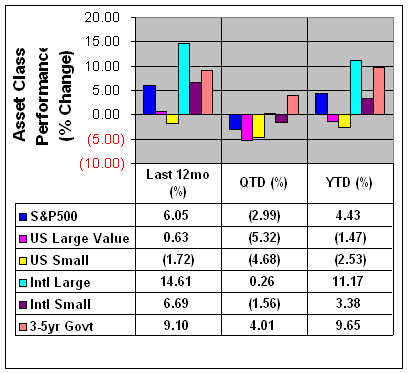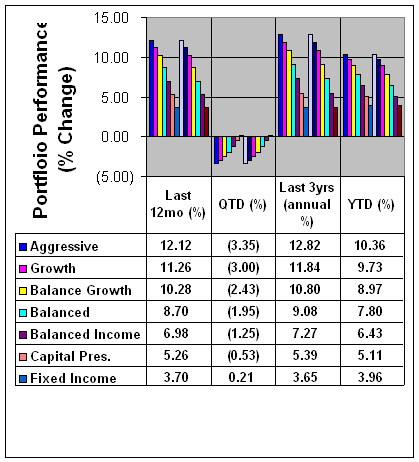|
|
 |
|
|
 |
| |
The
Robinson Report |
A quick
and simple weekly
market performance report.
|
Monday,
December 03, 2007
|
|
![]() |
| |
Week
in review:
-
The Markets
After three weeks of heavy
(panic?) selling in the equity markets, stocks posted the
biggest two-day rally in five years on Tuesday and Wednesday,
helping the Dow to end the week up 3.05 percent at 13,371.72.
The S&P rose 2.81 percent to 1,481.14, and the NASDAQ gained
2.48 percent to finish the week at 2,660.96.
-
Even Better
The economy did even better than thought in the
third quarter of 2007. The Commerce Department last week
revised its gross domestic product reading from the 3.9
percent initially reported to 4.9 percent. The revised figure,
attributed to strong exports and business inventory build-up,
met economist forecasts.
-
Costly Caregiving
Caregivers of aging or ailing parents or
spouses spend an average of $8,728 a year on out-of-pocket
expenses more than the average American household spends on
health care and entertainment combined, according to a survey
by the National Alliance for Caregiving and Evercase, a
division of the UnitedHealth Group. That amounts to roughly 10
percent of their household income, with the most common
caregiver expenses being food, transportation, medical
co-payments and medicines, clothing and home repair or
maintenance. Caregivers spend less on leisure activities,
vacations and major purchases or home improvements to cover
the costs.
-
Bride and Joy - Born between
1977 and 1996, peaking in 1990, the echo boom generation is
beginning to pour in masse into the workforce. If we can put
up with their special quirks, they may just be the next big
innovators. Barrowing a title from the WSJ,
"Younger Folks Narcissism May Enliven the Workplace",
please read on.
-
Top Ten Percent
It takes an adjusted gross income of $103,912
(i.e., approximately $2,000 per week) to rank in the top 10
percent of individual income tax returns (Source: IRS, BTN
Research).
-
Stocks and Fed Policy
Since the end of 1973, the S&P 500 has gained
17 percent on an annualized basis during periods of expansive
monetary policy (i.e., falling interest rates) and has gained
5 percent during periods of restrictive monetary policy (i.e.,
rising interest rates). The Fed has lowered interest rates
twice since Sept. 18, 2007, and next meets on Dec. 11, 2007
(Source: CFA Institute, BTN Research).
ASSET
CLASS RETURNS (see disclosures below) 

Portfolio
Performance REVIEW (see disclosures below)

|
|
|
Subscribe/Unsubscribe |
| |
"Art
is not what you see, but what you make others
see."
--Edgar Degas
|
|
|
|
|
% change in week ending 11/30/07 |
|
S&P500 |
2.81 |
|
US Lg Val (Russell 1000 Value) |
3.02 |
|
US Sm (Russell 2000) |
1.69 |
|
Intl (EAFE) |
3.04 |
|
Intl Sm (EAFE Small) |
2.92 |
|
3-5yr Govt (Bloomberg) |
0.42 |
|
Are you happy with your
investments?
The goal of RCM Robinson
Capital is to successfully advise public
institutions and private investors regarding
their institutional fixed income and investment
needs.
For more information, please
call 1-415-771-9421.
|
|
|
|
|
|
|
Important Performance Disclosure Information
|
|
Asset
Class returns are represented by market indexes that are
unmanaged baskets of securities. Investors cannot directly
invest in market indexes. Foreign securities involve additional
risks, including foreign currency changes, political risks,
foreign taxes and different methods
of
accounting and financial reporting.
Portfolio Performance is the total return of
seven unique asset allocation strategies that seek to fit the
distinct needs of different investor goals, risk tolerance
levels and investment time horizon. Each portfolio contains up
to 16 individual funds totaling over 4000 securities, managed by
OppenheimerFunds.
The portfolios are designed to create efficient diversification
through the selection of mutual funds that may have a low
correlation between asset classes.
The purpose of these tables and charts is for you to follow
specific market indexes, observe asset class rotation and to
compare actual portfolio returns net of management fees.
Asset allocation strategy is available
here.
Performance
quoted is past performance and cannot guarantee comparable
future results. Performance figures reflect reinvestment of
distributions and changes in net asset value (NAV). Investment
return and principal value will vary so that you may have a gain
or loss when you sell shares. The contingent deferred sales
charge (CDSC) on Class C is 1%. No CDSC will be imposed on redemptions
of Class C shares following one year from date shares were
purchased. Performance shown does not include applicable CDSC,
which would have reduced performance.
Before
investing in any of the
OppenheimerFunds, investors should
carefully consider a fund's investment objectives, risks,
charges and expenses. The fund's prospectus contains this and
other information about the fund. Read prospectuses
carefully before investing.
|
|
| S&P 500 - Standard & Poor's 500 Index (not
including dividends) - generally considered a U.S. Large Growth
company market index. |
|
Russell
1000 Value Index (US Lg Val) - generally considered a U.S.
Large Value company market index. |
Russell 2000 Index (US Sm)- generally considered a U.S.
Small company market index. |
|
EAFE - EAFE Index (Intl) (not including dividends) Europe,
Australia, Far East and generally considered a large company
international market index. |
|
EAFE Sm - EAFE Small Index (Intl Sm) (not including dividends)
Europe, Australia, Far East and generally considered a small company
international market index. |
|
Bloomberg Silicon Valley
Index - market index of high tech companies located in the Silicon
Valley area. |
Global Hedge Fund Index - representative
of the overall composition of the hedge fund universe. It is
comprised of eight strategies:
convertible arbitrage, merger arbitrage, equity hedge, equity market
neutral, relative value arbitrage, event driven, distressed
securities, and macro. The strategies are asset weighted based on
the distribution of assets in the hedge fund industry.
See hedge
fund risks. |
|
3-5yr Treas. - Bloomberg U.S. Government Treasuries
3-5 year maturities index and generally considered a intermediate
maturity U.S. Government Note index. |
|
Asset Class - a group of
investments that share similar risk and return characteristics. |
|
All investments involve
risk, including loss of principal. Foreign securities involve additional
risks, including foreign currency changes, political changes, foreign
taxes, and different methods of accounting and financial reporting.
The
foregoing has been prepared solely for informational purposes, and is not
an offer to buy or sell or a solicitation of an offer to buy or sell any
security or instrument or to participate in any particular trading
strategy.
The information contained herein is based on
sources and data believed reliable, but is not guaranteed. Advisory
services offered through RCM Robinson Capital Management LLC, SEC
Registered Investment Advisor. Securities offered through Securities
America, Inc., Member FINRA/SIPC. Douglas C. Robinson, Registered
Representative. RCM Robinson Capital Management LLC and Securities
America, Inc. are separate and unaffiliated.
|
|
|
|
|
|
|